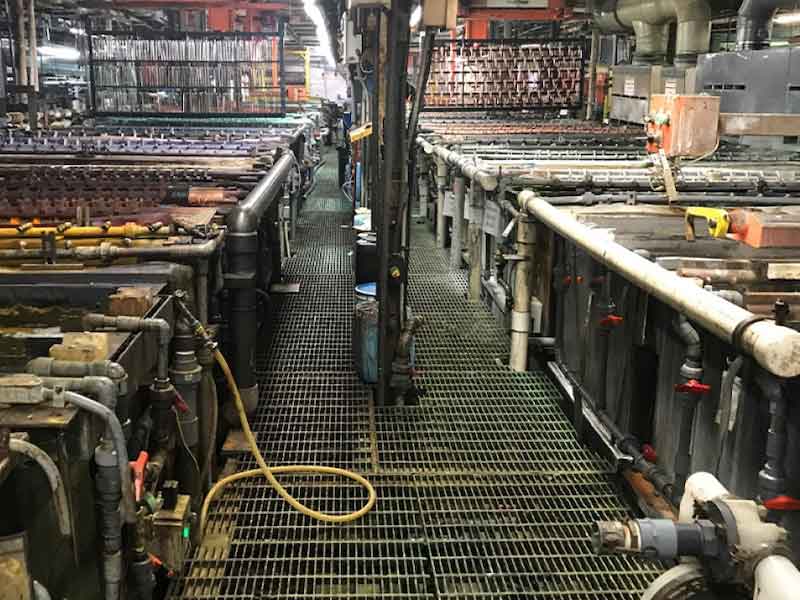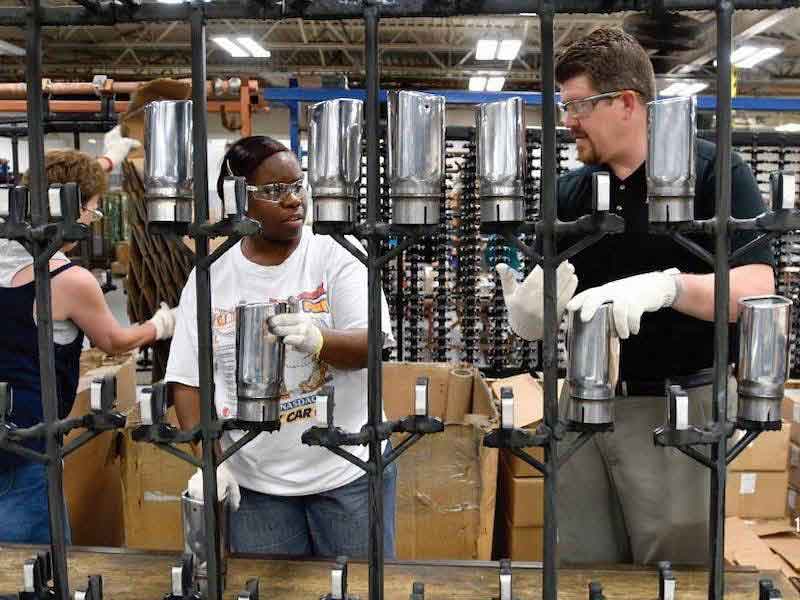Master Finish President John Mulder recently noticed that an inordinate amount of his staff’s time was being used to field calls from clients inquiring about the status of their orders.
 John MulderThat’s when the president of Grand Rapids-based metal plating and finishing company got with his team to create a customer-facing online portal that would give clients access to real-time updates as their parts moved from the loading dock through one of the facility’s three fully automated plating lines, and to the inspection process.
John MulderThat’s when the president of Grand Rapids-based metal plating and finishing company got with his team to create a customer-facing online portal that would give clients access to real-time updates as their parts moved from the loading dock through one of the facility’s three fully automated plating lines, and to the inspection process.
It’s these types of technological innovations that have served manufacturers like Master Finish well throughout the turbulent times of the pandemic. It also has left them hungry to explore additional automation and innovation as the industry establishes a new normal — one with far fewer workers in the building.
“A lot of (the focus on automation) is how do we reduce costs of scrap, reduce defects, reduce lead times for customers, and how do we provide better service?” Mulder said. “That’s what it’s all about.”
Ahead of the Curve
 As a third-generation family-owned business, Master Finish provides a wide range of metal plating services. Most of its business is used to supply automotive OEMs with metal plated parts.
As a third-generation family-owned business, Master Finish provides a wide range of metal plating services. Most of its business is used to supply automotive OEMs with metal plated parts.
While some of the more quintessential Industry 4.0 solutions might include robots, cobots, and advanced automation efforts, many of Master Finish’s measures are more subtle.
The company has automated its plating lines in a way that requires far less staff. Mulder — who runs the business with his brother, CEO Aaron Mulder — said a typical plating line requires a staff of seven or eight people. Master Finish is able to get by with one or two. And thanks to automation, those workers are able to focus on more advanced tasks instead of moving material.
Master Finish also uses automation in its dynamic scheduling board, which displays to workers on the shop floor the progress on each project for the week in addition to individual worker productivity.
The company also uses a tracing system that has proven to be a major boon for quality control. Each rack of parts is assigned an identification number. If a client has questions or concerns regarding the quality of a batch of parts, the Master Finish team can access detailed information on the batch’s production process. This allows them to make necessary changes to avoid quality issues in the future.
“We’re a relatively small company doing relatively innovative and world-class things,” Mulder said. “And it’s fun to be a part of that.”
These measures come as Master Finish is operating with a workforce of 90 people — around 16 employees short of a full staff. Mulder said that workforce shortages are causing the company to invest quite heavily into technology. Master Finish is currently working to bring machine vision technology to the shop floor as the company is low on certified inspectors.
Like many manufacturers, scoring a few wins with technology has made Mulder and his team hungry for more. He aspires to eventually implement robotic loading for racks when the technology exists and makes economic sense.
“It seems like we’ll have a new robotic integration company knock on our door every two or three years, and the ROI is getting closer,” Mulder said. “Where it used to be a 15- to 20-year ROI on a lot of that stuff, it’s getting closer to attainable — five years or less. Now it’s starting to look promising, especially with labor shortages.”
COVID Accelerated
While the pandemic has prompted some manufacturers to take a first look into automation and other tenets of Industry 4.0, “accelerate” is a recurring word manufacturers use regarding their tech journeys. For companies that have already dabbled in Industry 4.0, the pandemic accelerated those efforts significantly.
This rang true for Holland-based custom fabrication shop Impact Fabrication Inc. President Ross Haan said the company started looking into advanced technology in 2019, but the pandemic was a catalyst in thrusting those efforts forward.
“With a small business, you can get stuck in the rut of, ‘Hey, this is kind of what we’ve always done,’ and it works well enough until something radically shifts and makes you have to think about something differently,” Haan said.
In recent years, Impact has invested in a welding cobot that it was able to use right out of the box.
Haan manages a business that manufactures products with a high mix and low volumes. Technology upgrades served the company well as it saw a surge in orders over the last year.
“With our (enterprise resource planning) system, we are able to communicate and track products and help push the work through the shop,” he said. “So, we’re working on the correct project at the correct time. That was a big focus for us this year, having so much work coming through.”
Also, in the past year, Impact has dabbled in 3D printing, mainly to create prototypes or make replacement parts for their own machines.
Looking to Make Continued Advancements
As the company eyes a 50,000-square-foot expansion that is set to open in April, Haan and the team are looking to make continued advancements, like bringing together the company’s independently networked machines.
“There isn’t anything we’ve done where we thought that was money poorly spent,” Haan said. “Everything we’ve invested in so far has increased our flow and processes, so we’re working more efficiently and doing jobs more profitably. I think we’ve seen that in the past year.”
Pat Greene, president of Cutlerville-based Tier 2 auto supplier Cascade Die Casting Group Inc., also said COVID accelerated the company’s tech transition.
While the company’s die-casting operations were fairly automated to avoid the dangers of the process, Greene and his team have introduced new automation investments, like a machine vision camera that scans parts for imperfections and can also help in sorting.
“No human can sit there for eight to 10 hours a day and see everything, but a camera can,” Greene said. “You’re able to use it as a substitute for the person and make their job more fulfilling because they’re not doing that tedious and boring work.”
“We would have done this over the course of the next couple years, but now it’s a matter of, ‘Let’s do it quick — let’s do it soon,’” Greene added. “It will make people’s jobs easier, and that’s a big deal right now.”
This story originally ran in MiBiz and is republished with permission. Visit https://mibiz.com/sections/manufacturing/industry-4-0-makes-manufacturers-nimble-during-pandemic-hungry-for-more-innovation to read the entire article.



































